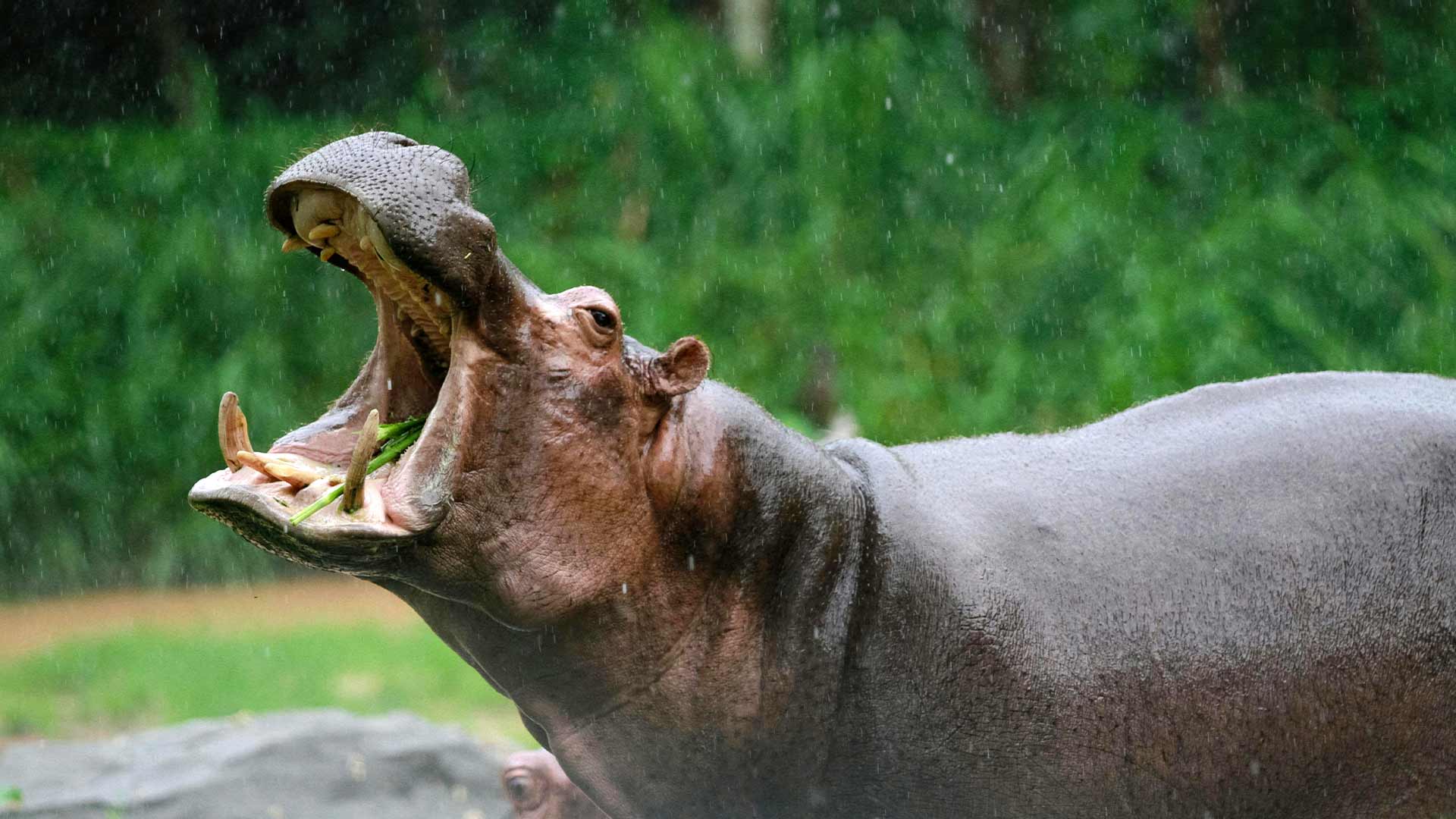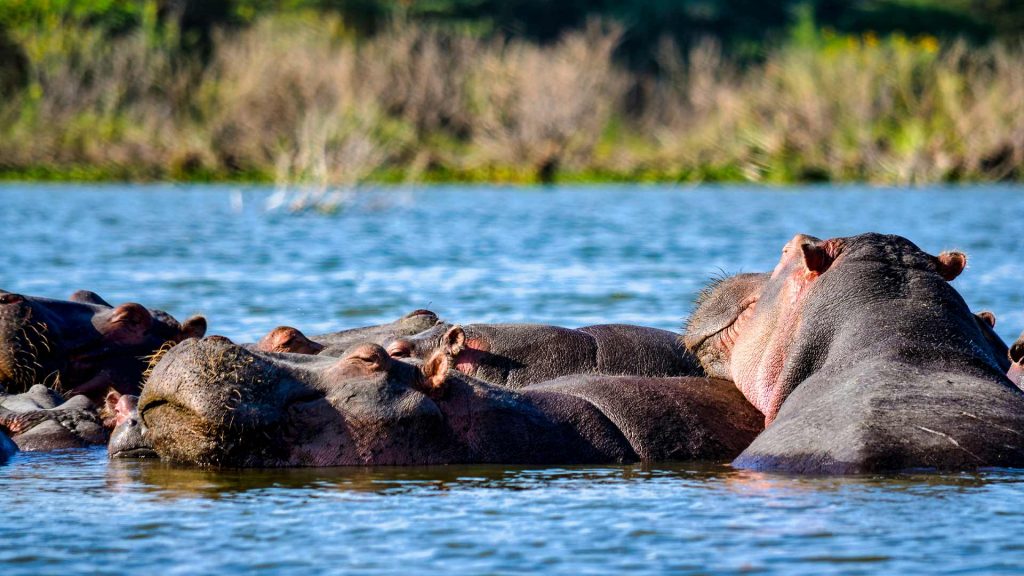Hippo
The hippopotamus, Hippopotamus amphibius, also known as Hippo, is a large, semi-aquatic mammal native to Africa. Known for its massive size and aggressive nature, hippos spend much of their time in water to stay cool and avoid sunburn.
Learn about their behaviour, physical description, habitat, diet, Lifespan, Geographical distribution, and 10 most fascinating FAQs.

Overview
The hippopotamus, scientifically known as Hippopotamus amphibius, also as just Hippo, is one of Africa’s most iconic and intriguing animals. Despite their bulky appearance and semi-aquatic lifestyle, hippos are surprisingly agile and aggressive, making them one of the most dangerous animals in Africa. Known for their massive size, distinctive barrel-shaped bodies, and large mouths, hippos play a crucial role in their ecosystems.
Species in Africa
There are two extant species of hippos in Africa:
- Common Hippopotamus (Hippopotamus amphibius): Found throughout sub-Saharan Africa in rivers, lakes, and swamps.
- Pygmy Hippopotamus (Choeropsis liberiensis): Smaller and more elusive, this species resides in the forests and swamps of West Africa, particularly in Liberia, Sierra Leone, Guinea, and Ivory Coast.
Scientific Classification
- Kingdom: Animalia
- Phylum: Chordata
- Class: Mammalia
- Order: Artiodactyla
- Family: Hippopotamidae
- Genus: Hippopotamus
- Species: Hippopotamus amphibius
Description
Hippopotamuses are one of the largest land mammals, distinguished by their massive bodies, short legs, and large heads. They are primarily nocturnal and spend much of their time in water to keep their large bodies cool under the African sun.
Size
Adult hippos typically weigh between 1,500 to 3,200 kilograms (3,300 to 7,100 pounds) and stand about 1.5 meters (5 feet) tall at the shoulder. They can reach up to 4 meters (13 feet) in length.
Skin
Their skin is thick and nearly hairless, with a gray to brown coloration. It secretes a natural sunscreen substance that is red-colored, often referred to as “blood sweat,” which protects them from sunburn and infection.
Mouth and Teeth
Hippos have enormous mouths and can open them up to 150 degrees. They have large, tusk-like canine teeth that can grow up to 50 centimeters (20 inches) long and are used for defense and fighting.
Eyes and Ears
Positioned high on their heads, their eyes and ears allow them to see and hear while mostly submerged in water. This adaptation helps them stay cool and avoid detection by predators.

Behaviour, Diet, Reproduction, and Lifespan
Behaviour
Hippopotamuses are semi-aquatic and spend much of their time in water bodies, which serve as a cooling mechanism and protection from the sun. They are social animals that live in groups called pods, bloats, or herds, usually consisting of around 10 to 30 individuals.
- Social Structure: Dominant males control territories in water bodies that include several females and their offspring. Males are highly territorial and aggressive, especially during the breeding season.
- Communication: Hippos communicate through vocalizations, including grunts, bellows, and wheezes. They also use body language, such as yawning, which can be a sign of aggression.
Diet
Hippos are herbivores, with a diet primarily consisting of grass. Despite their massive size, they are not ruminants like cows and have a simpler digestive system.
- Feeding Habits: Hippos graze on grasses at night, consuming up to 40 kilograms (88 pounds) of grass each night. They can travel several kilometers from water to find food.
- Water Dependency: Although they spend much time in water, hippos do not eat aquatic plants. They rely on terrestrial grasses for their nutrition.
Reproduction and Lifespan
Female hippos reach sexual maturity at around 5 to 6 years, while males mature at about 7 to 8 years. Breeding typically occurs in water, and after a gestation period of about 8 months, females give birth to a single calf, usually underwater.
Calves are nursed for up to a year, and mothers are highly protective. They often keep their young submerged with just their nostrils above the water’s surface.
In the wild, hippos can live up to 40 to 50 years, although in captivity, they may live slightly longer due to the absence of threats and better medical care.
Habitat and Geographical Distribution
Hippos are widely distributed across sub-Saharan Africa, inhabiting a variety of freshwater bodies such as rivers, lakes, and swamps. They require areas with both water for staying submerged during the day and adjacent grasslands for grazing at night.
In Kenya, hippos are commonly found in the Maasai Mara, Amboseli National Park, and Lake Naivasha. The Maasai Mara, with its abundant water sources and rich vegetation, provides an ideal habitat for hippos. Amboseli, known for its large elephant population, also supports significant hippo populations in its swamps and marshes.
In Tanzania, the Serengeti National Park and the Ngorongoro Crater are key habitats for hippos. The Serengeti’s rivers and the Ngorongoro’s crater lake offer perfect environments for these semi-aquatic mammals. The Rufiji River in the Selous Game Reserve is another important habitat.
Botswana boasts a large hippo population, particularly in the Okavango Delta and Chobe National Park. The Okavango Delta, with its intricate waterways and seasonal floods, supports a thriving hippo population. Chobe’s riverfront is another crucial habitat for these animals.
South Africa features hippos in Kruger National Park and St. Lucia Estuary in iSimangaliso Wetland Park. Kruger, one of Africa’s largest game reserves, supports healthy hippo populations in its numerous rivers and waterholes. The iSimangaliso Wetland Park, a UNESCO World Heritage site, offers diverse aquatic habitats that are perfect for hippos.
Zambia is home to significant hippo populations in the Luangwa River in South Luangwa National Park and the Zambezi River in Lower Zambezi National Park. South Luangwa’s riverine environment is ideal for hippos, while the Zambezi River offers extensive water habitats.
In Uganda, Murchison Falls National Park and Queen Elizabeth National Park are important hippo habitats. Murchison Falls, with the Nile River running through it, provides abundant water and vegetation. Queen Elizabeth National Park, with its Kazinga Channel, supports large hippo populations.
In Zimbabwe, hippos inhabit the Zambezi River in Mana Pools National Park and the waters of Lake Kariba. Mana Pools, a UNESCO World Heritage site, offers rich floodplains and water sources, while Lake Kariba’s expansive waters support numerous hippos.
In Mozambique, hippos can be found in Gorongosa National Park, which has seen a remarkable recovery in wildlife populations. The park’s diverse water habitats provide excellent conditions for hippos.
In Malawi, Liwonde National Park and Lake Malawi are key hippo habitats. Liwonde, with the Shire River running through it, supports a healthy hippo population, while Lake Malawi offers extensive aquatic habitats.
In Namibia, hippos are present in the Caprivi Strip, particularly in Bwabwata National Park. The park’s floodplains and waterways provide ideal conditions for hippos.
Conservation
The hippopotamus (Hippopotamus amphibius) is currently classified as Vulnerable on the International Union for Conservation of Nature (IUCN) Red List. This classification indicates that hippos are at risk of becoming endangered if the factors threatening their survival and reproduction continue unabated. The primary threats to hippo populations include habitat loss, human-wildlife conflict, and illegal hunting. Habitat loss is driven by agricultural expansion, urban development, and water diversion projects, which reduce the availability of essential water bodies and grazing areas.
Facts
Interesting facts about The Hippopotamus.
Hippos spend most of the day submerged in water to keep cool and avoid sunburn. They become more active at night when they leave the water to graze on land.
Despite their large size, hippos can run at speeds of up to 30 kilometers per hour (19 miles per hour) on land over short distances.
The red-colored substance secreted by hippos’ skin acts as a natural sunscreen and antibiotic, protecting them from the sun and infections.
Yes, hippos are considered one of the most dangerous animals in Africa. They are highly territorial and can be very aggressive, especially if they feel threatened.
Hippos live in groups called pods, bloats, or herds, typically consisting of a dominant male, several females, and their offspring. The social hierarchy is maintained by the dominant male.
Hippos communicate through a variety of vocalizations, body language, and even underwater sounds. They use grunts, roars, and bellows to convey different messages.
Hippos are herbivores that primarily graze on grass. They feed at night, consuming up to 40 kilograms (88 pounds) of grass each night.
Female hippos reach sexual maturity at around five to six years of age, and males at about seven to eight years. After a gestation period of approximately eight months, the female gives birth to a single calf.
In the wild, hippos can live up to 40 to 50 years. In captivity, they may live even longer due to better care and the absence of predators.
Hippos can hold their breath and stay submerged for up to five minutes. They can also sleep underwater, surfacing for air without waking up due to a reflex that automatically prompts them to breathe.
Other Animals
Explore fauna in Africa.






